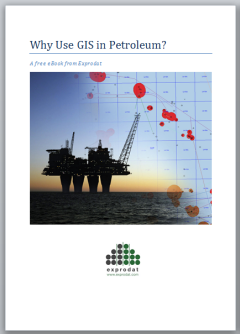 Why should we use GIS? This is probably the question we hear most often in our discussions with our petroleum clients. And it’s not just from those oil and gas companies who have yet to embrace GIS – we sometimes hear this from companies that have already invested considerably in supporting technology and projects, but feel they don’t still properly understand the reasons for doing so.
Why should we use GIS? This is probably the question we hear most often in our discussions with our petroleum clients. And it’s not just from those oil and gas companies who have yet to embrace GIS – we sometimes hear this from companies that have already invested considerably in supporting technology and projects, but feel they don’t still properly understand the reasons for doing so.
I thought it would be useful to list a few of my favourite examples of where GIS has delivered a clear business benefit to the organisation where it has been deployed. Most of these are taken from our new free eBook “Why Use GIS in Petroleum?” which we have made available for download.
So, in no particular order, here are my top 10 uses of GIS in oil and gas.
1. Data index maps – One of the most common uses of GIS in the petroleum sector is in delivering easy-to-use digital maps that enable oil company staff to see what data is available to them, so that they can drastically reduce the amount of time they spend looking for the information they need to do their work. Often such maps are delivered using web-based GIS applications that require little or no training to use, and show all data of interest side-by-side in a single interface.
2. Block ranking – Ranking opportunities via quantitative analysis using all available information require data integration on a massive scale, and so it is usually seen as too time consuming to carry out on a regular basis. However, GIS provides the perfect environment in which to rapidly evaluate and grade oil and gas licenses or lease blocks. It provides a unique way of mining large quantities of different types of data in order to help make a decision, and many companies employing GIS for this analysis believe that it gives them a competitive edge in license acquisition.
3. Land management – The way GIS stores information as attributes allows a ‘land man’ to map key lease data such as lessor names, lease expiry dates, working interests (WI), overriding royalty (OR), overriding royalty interest (ORRI), net revenue interest (NRI) and gross/net acreages. Meanwhile centralising all land management data in an enterprise GIS environment helps enormously when generating the reports that are requirement by regulators.
4. Well planning – GIS is being used increasingly for well planning, particularly with the rise of unconventional resources such as shale gas, shale oil and coal bed methane. Not only can GIS be used to plan well pad patterns around multiple surface drilling constraints, but its unique spatial analytics can be used to optimise drilling patterns to calculate the most efficient drilling configuration.
5. Field operations – An emerging use of GIS is in using flying sensor technology to gather on-demand high resolution imagery across a field location in order to survey a site. This allows companies to regularly monitor sites and to identify and manage change, without having to commission expensive satellite data capture.
6. Environmental monitoring – Given the current focus on shale play development, it is essential that companies are able to accurately monitor environmental changes associated with operations. GIS is invaluable in this regard, able to integrate and visualise time stamped data against a base lined case, e.g. using regularly updated DEMs to help detect subsidence caused by extraction of the resources.
7. Pipeline routing – Building pipelines to carry petroleum products is capital-intensive, so determining the optimum route is critical. This is a non-trivial task that can be significantly simplified through the use of ‘least-cost path analysis’ – a process that identifies the route of least resistance between a source point and destination, based on the effort required to pass through cells in one or more cost raster datasets, such as slope (based on a DEM) and land-cover. Studies have shown that GIS-based least cost path analysis can produce more environmentally friendly routes, as well as reducing costs by up to 15%.
8. Vessel tracking – GIS can be useful for tracking valuable assets, especially those that are mobile, such as vehicles and boats. Knowing the precise location of vehicles and vessels is essential for the timely delivery of goods and services, as well as for efficient emergency response.
9. Emergency response – GIS is becoming increasingly important in response to emergencies such as oil spills and gas explosions, both in mitigation planning and response management. Data loaded into a GIS can be made available to all stakeholders regardless of their physical location (e.g. to workers in the field on mobile devices), and even to the public. This leads to better decision making during emergency response situations, and improved public relations.
10. Pipeline monitoring – Pipelines need to be continually monitored to check for leaks and geo-hazards, and to manage and track inspections, the frequency of which is often a regulatory requirement. An emerging use of GIS is in integrating the map with digital video, often acquired using remote vehicles on the seabed, enabling engineers to see sections of pipeline and monitor hazards affecting the installation.
I’m sure I’ve missed out a few so if feel free to post a comment suggesting your own favourites. And if you’d like to find out more about how your organisation can benefit from applying intelligent mapping and location analytics technology provided by GIS, then why not download our free eBook “Why Use GIS in Petroleum?” for further detail.
Posted by Chris Jepps, Technical Director, Exprodat.






